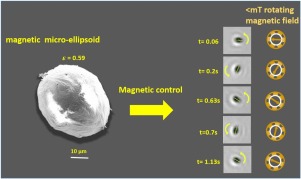Applied Materials Today ( IF 8.3 ) Pub Date : 2019-12-01 , DOI: 10.1016/j.apmt.2019.100511 Andrea Bonilla-Brunner , Isabel Llorente García , Bumjin Jang , Midori Amano Patiño , Viraj Alimchandani , Bradley J. Nelson , Salvador Pané , Sonia Contera

|
Polymeric magnetic spherical microparticles are employed as sensors/actuators in lab-on-a-chip applications, small-scale robotics and biomedical/biophysical assays. Achieving controlled stable motion of the microparticles in a fluid environment using low intensity magnetic fields is necessary to achieve much of their technological potential; this requires that the microparticle is magnetically anisotropic, which is difficult to achieve in spheres. Here we have developed a simple method to synthesise anisotropic ellipsoidal microparticles (average eccentricity 0.60 ± 0.14) by applying a magnetic field during synthesis, using a nanocomposite of polycaprolactone (PCL) with Fe3O4 nanowires. The “microellipsoids” are thoroughly characterised using optical microscopy, scanning electron microscopy (SEM), transmission electron microscopy (TEM) and energy dispersive X-ray spectroscopy (EDX). Their suitability for magnetically controlled motion is demonstrated by analysing their rotation in low magnetic fields (0.1, 1, 5, 10 and 20 mT) at varying rotational frequencies (1 Hz and 5 Hz). The microellipsoids are able to follow smoothly and continuously the magnetic field, while commercial spherical particles fail to continuously follow the magnetic field, and oscillate backwards and forwards resulting in much lower average angular speeds. Furthermore, only 23 % of commercial particles analysed rotated at 1 Hz and 26 % at 5 Hz, whereas 77 % of our ellipsoidal particles rotated at 1 Hz, and 74 % did at 5 Hz.
中文翻译:

具有可编程磁各向异性的聚合物微椭球体,可使用低(≈10mT)磁场控制旋转
聚合物磁性球形微粒在芯片实验室应用,小型机器人技术和生物医学/生物物理测定中用作传感器/致动器。使用低强度磁场在流体环境中实现微粒的受控稳定运动是实现其大部分技术潜力所必需的;这要求微粒是磁性各向异性的,这在球形中很难实现。在这里,我们开发了一种简单的方法,通过在合成过程中施加磁场,使用带有Fe 3 O 4的聚己内酯(PCL)纳米复合材料,合成各向异性椭圆体微粒(平均偏心率0.60±0.14)纳米线。使用光学显微镜,扫描电子显微镜(SEM),透射电子显微镜(TEM)和能量色散X射线光谱仪(EDX)对“微椭球体”进行了全面表征。通过分析它们在变化的旋转频率(1 Hz和5 Hz)下在低磁场(0.1、1、5、10和20 mT)中的旋转,证明了它们适用于磁控运动。微椭球体能够平稳且连续地跟随磁场,而商用球形颗粒无法连续跟随磁场,并且会前后振荡,从而导致平均角速度低得多。此外,只有23%的商业颗粒在1 Hz时旋转,而26%在5 Hz时旋转,而我们的椭圆形颗粒在1 Hz时旋转,而74%在5 Hz时旋转。



























 京公网安备 11010802027423号
京公网安备 11010802027423号